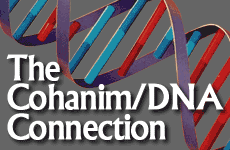J
Jazer
Guest
I gave that to you, I have put that information out on this board many times. Maybe you are new and did not see that I put that information up again and again. We are talking about the J2B3 Halpogroup. Now they may change this at anytime. They may find a new mutation at any time. But currently this is the most recent information we have from Science. You can get what you need from Wiki.I need several peer-reviewed sources from legitimate scientific journals to confirm these claims: "the MtDNA confirms who the Clam Mother is for the Hebrew People. We know where she lived and when she lived. Science and the Bible both say Even lived in the same place at the same time"
If you say this is true, you should provide rock-solid evidence for it.
Around 45,000 years before present, a mutation took place in the DNA of a woman who lived in the Near East or Caucasus. Further mutations took place in the J line which can be identified as J1a1 (27,000 yrs ago), J2a (19,000 yrs ago), J2b2 (16,000 years ago), J2b3 (5,800 yrs ago), etc. Haplogroup J (along with ‘T’


J1
Main article: Haplogroup J1 (Y-DNA)
ISOGG states that J1 originated in the Middle East. It is found in parts of the Near East, and North Africa, with a sparse distribution in the southern Mediterranean flank of Europe, and in Ethiopia. But not all studies agree on the point of origin. The Levant has been proposed but a 2010 study concluded that the haplogroup had a more Northern origin.[citation needed] The origin of J1c3 is likely in the more northerly populations and then spreads southward into the Arabian Peninsula. The high YSTR variance of J1c3 in Turks and Syrians supports the inference of an origin of J1c3 in nearby eastern Anatolia. Moreover, the network analysis of J1c3 haplotypes shows that some of the populations with low diversity, such as Bedouins from Israel, Qatar, Sudan and UAE, are tightly clustered near high-frequency haplotypes suggesting founder effects with star burst expansion in the Arabian Desert. " [12] Haplogroup J1, defined by the 267 marker is most frequent in the Arabian Peninsula Yemen(76%),[13] Saudi (64%),[14] Qatar (58%),[15] and Dagestan (56%).[8] J1 is generally frequent amongst Arab Bedouins (62%.[16] , Ashkenazi Jews (14-20%),[17] North Sudan (45%, Khartoum 74%),[18] Algeria (35%),[17] Iraq (33%),[17] Tunisia (31%),[19] Syria (30%), Egypt (20%),[20] and the Sinai Peninsula. The frequency of Haplogroup J1 collapses suddenly at the borders of Arabic speaking countries with mainly non-Arabic speaking countries, such as Turkey (9%), Iran (11%).[1][9] It is also highly frequent among Jews, especially the Kohanim line (46%) [1] [21] .
[edit]J2
Main article: Haplogroup J2 (Y-DNA)
Haplogroup J2 is found in the highest concentrations in the Caucasus and the Fertile Crescent and is found throughout the Mediterranean (including the Italian, Balkan, Anatolian and Iberian peninsulas and North Africa).[22]
The highest ever reported concentration of J2 was 72% in Northeastern Georgia.[23] Other high reports include Ingush 32%,[23] Cypriots 30-37% (Capelli 2005), Lebanese 30% (Wells et al. 2001), Iraqis 29.7% (Sanchez et al. 2005), Syrians 22.5%[citation needed], Kurds 24%-28%, Iranians 23%,[24] Ashkenazi Jews 24%, Palestinian Arabs 16.8%-25%, Sephardic Jews 29%[2] and North Indian Shia Muslims 18%,[1] Chechens 26%, Balkars 24%, Yaghnobis 32%, Armenians 21-24%, and Azerbaijanis 24%-48%.
Consistent with its Middle Eastern extent, J2 also includes the Cohen Modal Haplotype. WIKI
More recent research, using a larger number of Y-STR markers to gain higher resolution more specific genetic signatures, has indicated that about half of contemporary Jewish Kohanim, who share Y-chromosomal haplogroup J1c3 (also called J-P58), do indeed appear to be very closely related. A further approximately 15% of Kohanim fall into a second distinct group, sharing a different but similarly tightly related ancestry. This second group fall under haplogroup J2a (J-M410). A number of other smaller lineage groups are also observed. Only one of these haplogroups could indicate ancestry from Aaron.
The J1e and J2a possible Cohen clusters (only one of them could indicate ancestry from Aaron), when including those tested who are of Sephardi background, have been estimated as descending from most recent common ancestors living 3,200 ± 1,100 and 4,200 ± 1,300 years ago respectively. Ashkenazis only have been estimated by the same article as descending from most recent common ancestors living 2,400 ± 800 and 3,800 ± 1,200 years ago respectively.[1] WIKI
If WIKI is to complicated try some of these links: The DNA Chain of Tradition
The Discovery of the "Cohen Gene" http://www.cohen-levi.org/jewish_genes_and_genealogy/the_dna_chain_of_tradition.htm
The fascinating story of how DNA studies confirm an ancient biblical tradition. http://www.aish.com/ci/sam/48936742.html

Last edited:
Upvote
0



